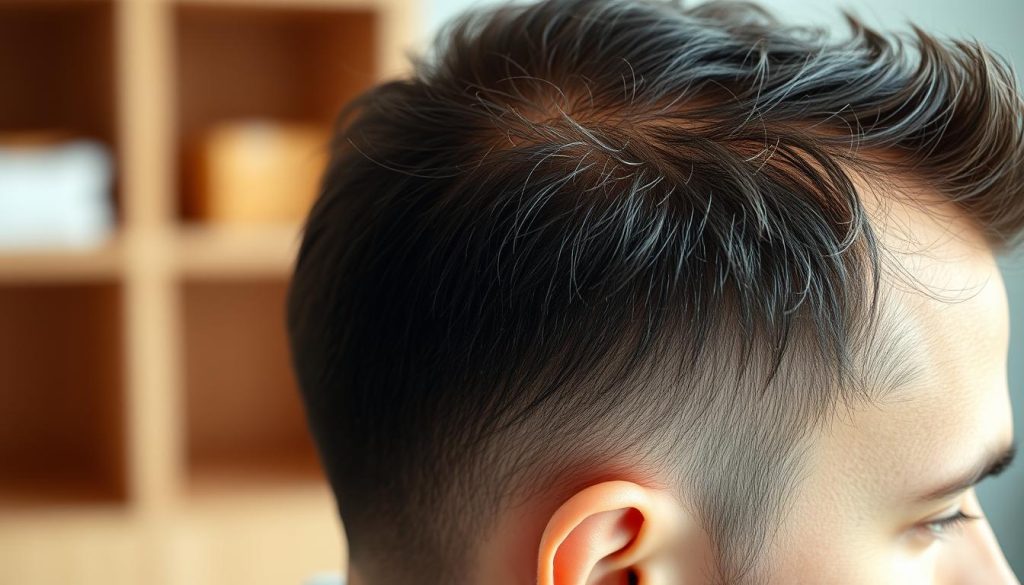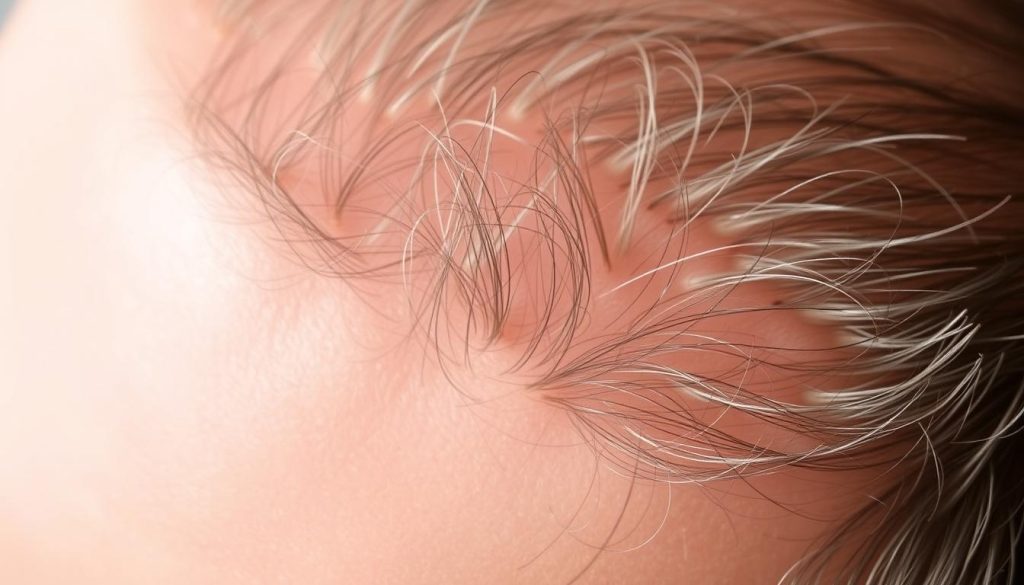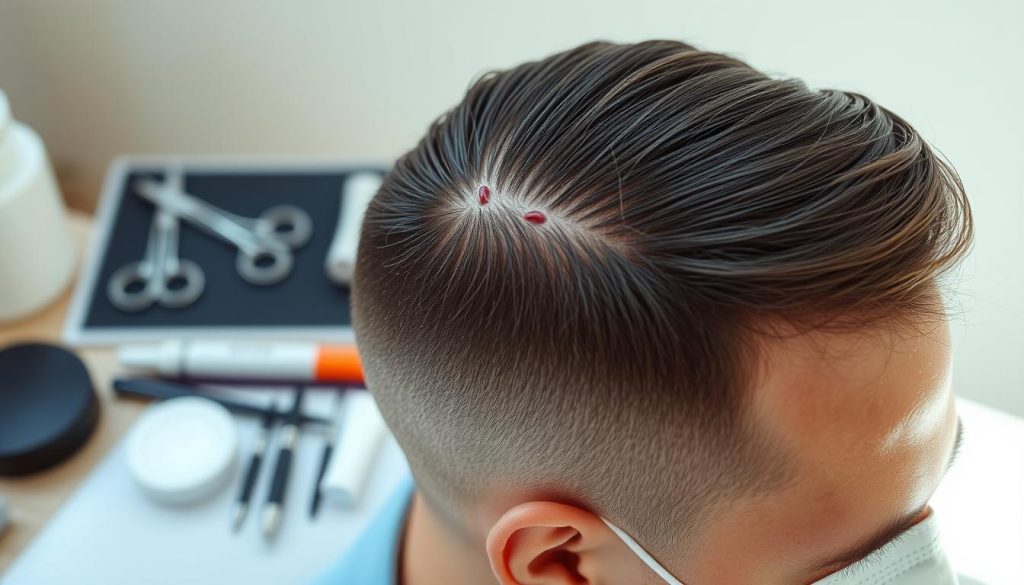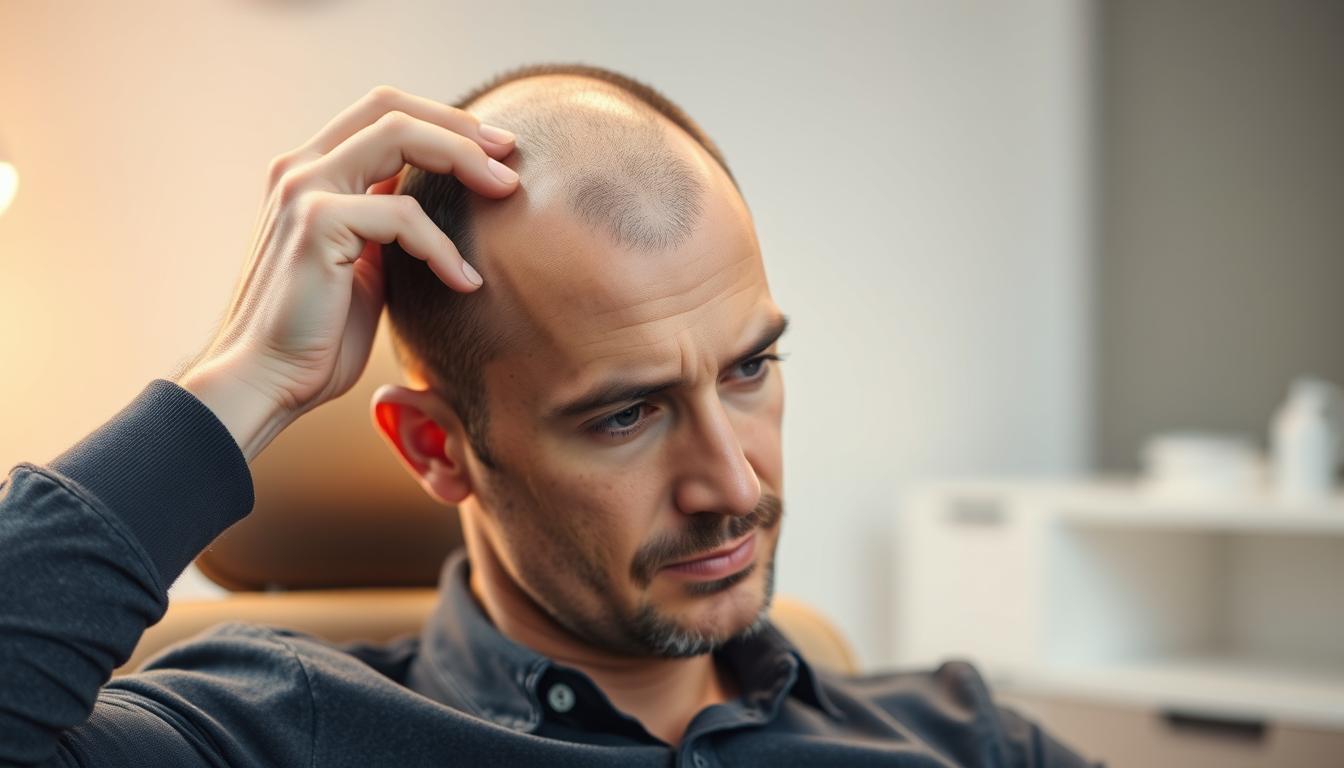Undergoing a hair transplant is a significant decision, and understanding the recovery process is crucial for achieving the desired results.
The recovery timeline for a hair transplant typically spans 12-18 months, during which patients can expect various phases of healing and growth.
Initially, the focus is on healing the scalp and protecting the newly transplanted grafts. As the recovery progresses, patients can expect to see new hair growth and maturation.
Key Takeaways
- The complete hair transplant recovery process takes around 12-18 months.
- Initial recovery focuses on healing the scalp and protecting grafts.
- Patients may experience temporary shedding before new growth begins.
- Understanding the normal symptoms and growth timeline is essential.
- Monitoring progress and seeking medical advice when necessary is crucial.
Understanding Hair Transplant Surgery and Recovery
Hair transplant procedures have evolved significantly, offering patients a range of options for addressing hair loss. The choice of procedure depends on several factors, including the extent of hair loss, donor hair availability, and the patient’s desired recovery time.
Types of Hair Transplant Procedures
There are two primary types of hair transplant procedures: FUE (Follicular Unit Extraction) and FUT (Follicular Unit Transplantation). FUE involves extracting individual follicular units directly from the donor area, resulting in minimal scarring and faster recovery times. On the other hand, FUT involves removing a strip of scalp from the donor area, which is then dissected into individual grafts for transplantation, leaving a linear scar.
- Hair transplant surgery involves relocating healthy hair follicles from donor areas to balding or thinning areas.
- The choice between FUE and FUT depends on factors such as the extent of hair loss, donor hair availability, and budget considerations.
- Both procedures are performed under local anesthesia and typically take several hours to complete.
Understanding the differences between these transplant procedures helps patients make informed decisions about which approach best suits their needs and recovery expectations. By choosing the right hair transplant procedure, patients can achieve optimal results and minimize downtime.
The Hair Growth Cycle Explained
Understanding the hair growth cycle is essential for individuals considering a hair transplant. The hair growth cycle consists of four distinct phases that play a crucial role in determining the success of the transplant.
Four Phases of Hair Growth
The natural hair growth cycle is composed of four phases: anagen, catagen, telogen, and exogen. During the anagen phase, which lasts 2-6 years, hair actively grows at a rate of approximately half an inch per month, with about 80-90% of hair follicles in this phase at any given time.
The catagen phase is a short transitional period lasting 2-3 weeks where hair growth stops and the follicle shrinks, affecting roughly 5% of hair follicles. In the telogen phase, which lasts about 3 months, the hair follicle rests while still holding the hair strand in place, with 10-15% of follicles typically in this phase.
The exogen phase involves the actual shedding of hair as new growth begins to emerge from the follicle. Most people lose 50-100 hairs daily through this natural process. Understanding these phases helps patients comprehend why transplanted hair initially sheds before new growth appears, providing context for the recovery timeline after a transplant procedure.
- The anagen phase is the active growth phase, lasting 2-6 years.
- The catagen phase is a short transitional period lasting 2-3 weeks.
- The telogen phase is the resting phase, lasting about 3 months.
- The exogen phase involves the shedding of hair as new growth emerges.
By understanding the hair growth cycle and its various phases, individuals can better anticipate the results of their transplant and manage their expectations regarding hair loss and regrowth.
Immediate Post-Op Recovery: Days 1-3
Understanding what to expect during the initial days after hair transplant surgery can help patients prepare for a smooth recovery. The first 72 hours are particularly crucial for graft survival, and patients must carefully follow post-operative instructions to ensure the best possible outcome.
Normal Symptoms to Expect
During the first few days following hair transplant surgery, patients may experience a range of normal symptoms, including swelling, redness, itching, and mild discomfort around the transplant area. The graft sites will typically form scabs within 24 to 72 hours after surgery. These reactions are normal and usually subside quickly.
Some common symptoms during this period include swelling, redness, mild pain, and the formation of small scabs around each transplanted follicle. Swelling often begins at the donor site and may progress to the forehead and around the eyes by the second or third day, peaking around 48-72 hours post-surgery. Patients may also experience a tight sensation in the scalp and occasional bleeding from the donor or recipient areas, which can be managed by applying gentle pressure with sterile gauze.
- The first 72 hours after a hair transplant are critical for graft survival.
- Patients may experience swelling, redness, and mild pain during this period.
- Sleeping with the head elevated at a 45-degree angle can help minimize swelling and protect grafts.
By understanding these normal symptoms and taking appropriate care, patients can navigate the immediate post-operative recovery phase with confidence, setting the stage for a successful hair transplant recovery.
Early Healing Phase: Days 4-10
The early healing phase, spanning from days 4 to 10, is crucial for a successful hair transplant recovery. During this period, the body continues to heal from the surgery, and the scalp starts to recover more noticeably.
Scab Formation and Removal
By days 4-10, swelling should subside and redness should fade. Patients should gently remove graft crusts by thoroughly soaking and then gently rubbing them with a finger. It is essential for scabbing to be cleared away to not inhibit new hair growth, but scabs must be removed gently to avoid damaging the transplanted grafts.
Most surgeons recommend beginning gentle washing of the recipient area around day 3-4, using specific techniques to soften and gradually remove scabs without dislodging the grafts. Patients should avoid scratching the scalp despite potential itchiness, as this could dislodge grafts before they’re fully secured in their new location.
- Gentle washing and scab removal are crucial during this phase.
- Avoiding direct sunlight and strenuous physical activity is recommended.
- Keeping the scalp clean according to the surgeon’s guidelines is vital.
By day 7-10, most visible signs of the procedure begin to fade, with redness diminishing and the donor area healing progressing significantly. This period requires continued vigilance in following aftercare instructions to ensure optimal recovery and healing.
The Shedding Phase: Weeks 2-4
The shedding phase, typically occurring between weeks 2-4 post-transplant, is a normal part of the recovery process after a hair transplant. During this period, the transplanted hair may begin to fall out, a phenomenon that can be alarming if not anticipated.
Why Transplanted Hair Falls Out
The hair transplant procedure involves relocating hair follicles from one part of the body to another. This relocation can cause the transplanted hair to enter the telogen phase, a resting state, leading to the shedding of the hair shaft. It’s crucial to understand that while the visible hair falls out, the hair follicles remain intact beneath the scalp, ready to begin a new growth cycle.
- The shedding phase is a normal and expected part of the hair transplant recovery.
- This phase occurs due to the trauma of transplantation, pushing hair follicles into the resting phase.
- Not all transplanted hairs shed at the same rate; some patients may experience minimal shedding.
- The shedding does not indicate failure of the transplant but rather a resetting before new growth begins.
Understanding this process can help manage expectations during the recovery period, typically between weeks 2-4 post-procedure.
Hair Transplant Recovery Timeline: Months 1-3

During the first three months post-hair transplant, the body undergoes various changes as it heals. This period is crucial in the hair transplant recovery process.
The Dormant Phase Explained
Months 1-3 after a hair transplant represent what’s commonly called the “dormant” or “hibernation” phase, where little visible growth occurs. During this period, the transplanted follicles are establishing their blood supply and preparing for new growth, though this activity isn’t visible on the surface.
The key aspects of the dormant phase include:
- Months 1-3 after a hair transplant represent what’s commonly called the “dormant” or “hibernation” phase, where little visible growth occurs.
- During this period, the transplanted follicles are establishing their blood supply and preparing for new growth, though this activity isn’t visible on the surface.
- Many patients experience what’s called the “ugly duckling” phase during this time, as they may have little to no hair in the transplanted areas following the shedding phase.
- By the end of the third month, some patients begin to see tiny new hairs emerging from the transplanted follicles, though this timeline can vary significantly between individuals.
- The dormant phase can be psychologically challenging for patients eager to see results, making it important to understand that this is a normal part of the hair transplant recovery process.
- Maintaining proper scalp care during this period remains important, including protecting the scalp from sun exposure and following any ongoing care instructions from the surgeon.
It’s essential for patients to stay positive during this phase, as initial hair transplant results do not indicate the overall success of the surgery. New growth is just a few months away, and understanding the hair transplant recovery timeline can help manage expectations.
Initial Growth Phase: Months 3-6
Between months 3-6, a significant transformation takes place as the transplanted hair begins to grow, marking a crucial milestone in the recovery process. During this period, patients typically start to notice the first signs of new hair growth emerging from the transplanted follicles.
First Signs of New Hair Growth
The initial growth often appears as fine, thin, and sometimes colorless hair that gradually thickens and darkens as it matures. Growth patterns may be uneven during this phase, with some areas showing more rapid development than others, which is a normal part of the recovery process.
By month 4-5, many patients have enough new growth to begin camouflaging the transplanted areas, though the hair remains noticeably thinner than it will ultimately become. The new growth may initially have a different texture or appearance compared to surrounding hair, but will gradually take on characteristics more similar to the patient’s natural hair.

To better understand the progression of hair growth during this phase, consider the following key aspects:
- New hair growth is typically fine and thin.
- Growth patterns can be uneven.
- The new hair may have a different texture initially.
| Month | Hair Growth Progress | Characteristics |
|---|---|---|
| 3 | Initial growth begins | Fine, thin, colorless |
| 4-5 | Growth becomes more noticeable | Thickens, darkens |
| 6 | Significant progress in growth | More uniform, natural appearance |
This phase marks an important psychological milestone for many patients, as the visible progress provides reassurance that the procedure is working as expected.
Significant Growth Phase: Months 6-9
The period between months6-9 is crucial for hair transplant patients, marking a significant acceleration in the growth and maturation of transplanted hair follicles.
During this phase, patients generally see substantial improvements in density and coverage as more follicles enter the active hair growth phase and existing hairs continue to thicken.
Maturation and Density Gains
As the transplanted hair continues to mature, patients can expect significant enhancements in their hair’s texture and appearance. By month8-9, many patients have achieved approximately60-70% of their final hair transplant results, with enough density to style their hair in ways that were not possible before the procedure.
The maturation process refers to the darkening, thickening, and normalizing of the hair. As hair growth patterns become more consistent, previously patchy areas fill in, creating a more uniform appearance across the transplanted region.
- Significant acceleration in the growth and maturation of transplanted hair follicles.
- Substantial improvements in density and coverage.
- Hair texture and color continue to normalize.
- By month8-9, patients achieve approximately60-70% of their final hair transplant results.
This phase often brings significant psychological benefits as patients begin to fully appreciate the transformation taking place and can more confidently present themselves socially and professionally.
Final Results: 12-18 Months Post-Transplant
The final outcome of a hair transplant procedure is usually visible within 12 to 18 months post-transplant. At this stage, the transplanted hair has fully matured, and the results are more apparent.
By this time, the transplanted hair has not only grown but has also matured in terms of thickness, texture, and density, creating a natural-looking result that blends seamlessly with the existing hair. As stated by experts, “The transplanted follicles have established their permanent growth cycle and will continue to produce hair throughout the patient’s lifetime, just like the original donor hair.”
What to Expect in Your Final Results
Most patients achieve 90-100% of their final density by the 12-month mark, with subtle improvements continuing for up to 18 months, particularly in crown areas which typically mature more slowly. The final results should provide natural-looking coverage that can be styled, cut, and treated just like natural hair.
- The transplanted hair maintains its density over time, though non-transplanted areas may continue to experience hair loss due to underlying conditions.
- Patients can expect their transplanted hair to continue growing naturally, requiring no special care beyond normal hair maintenance.
It’s essential to note that while the transplanted hair is permanent, the overall appearance can be affected by the progression of hair loss in non-transplanted areas. Nonetheless, a successful hair transplant can significantly enhance one’s appearance and confidence.
How to Optimize Your Hair Transplant Recovery
Optimizing hair transplant recovery involves a multi-faceted approach that includes medications, treatments, and lifestyle adjustments. A well-planned recovery strategy can significantly enhance the outcome of the transplant.
Medications and Treatments to Enhance Growth
Certain medications and treatments can be employed to enhance hair growth after a transplant. Finasteride is a commonly prescribed drug that helps prevent further hair loss and stimulate growth in both transplanted and non-transplanted hair. Research indicates that Finasteride can visibly enhance hair growth in 94% of patients post-transplant.
Another effective treatment is Minoxidil, which encourages post-transplant hair growth while minimizing graft shedding. Using topical Minoxidil after a FUT or FUE hair transplant can increase hair density and accelerate regrowth.
Other treatments that may be recommended include Low-Level Laser Therapy (LLLT) devices to enhance circulation and stimulate follicular activity, and Platelet-rich plasma (PRP) treatments to accelerate healing and stimulate growth.
| Treatment | Benefits |
|---|---|
| Finasteride | Prevents hair loss, stimulates growth |
| Minoxidil | Encourages hair growth, minimizes shedding |
| LLLT | Enhances circulation, stimulates follicles |
| PRP Treatments | Accelerates healing, stimulates growth |

Nutritional supplements such as biotin, zinc, and vitamins D and E are also recommended to support optimal hair growth. These should be used as part of a comprehensive approach rather than as standalone treatments.
When to Contact Your Surgeon During Recovery
Understanding when to contact your surgeon during the hair transplant recovery process is crucial for achieving optimal results. While most hair transplant recoveries proceed without complications, being aware of potential issues can help you address them before they affect your outcome.
Immediate concerns that warrant contact with your surgeon include excessive bleeding that doesn’t stop with gentle pressure, severe pain not managed by prescribed medications, signs of infection such as increasing redness, warmth, or pus, and fever above 101°F (38.3°C). During the first week, it’s essential to monitor for displaced grafts, persistent swelling that doesn’t improve after 4-5 days, or allergic reactions to prescribed medications.
In the weeks following surgery, report any unusual or excessive shedding beyond the normal shock loss period, persistent numbness or tingling lasting more than a few weeks, or the development of cysts in the recipient area. As you progress through the hair transplant recovery timeline, consult your surgeon if you observe no signs of new growth by month 4-5, significant asymmetry in growth patterns after month 6, or continued hair loss in non-transplanted areas that might require additional treatment.
Most reputable surgeons offer comprehensive follow-up care and encourage patients to reach out with any concerns, no matter how minor they may seem, to ensure optimal results and patient satisfaction. By choosing a qualified and experienced surgeon and being aware of when to seek guidance, you can maximize the success of your hair transplant procedure.
FAQ
What is the typical recovery process after a FUE hair transplant?
The recovery process typically involves some scalp discomfort, swelling, and redness, which can be managed with medication and post-operative care instructions provided by the surgeon.
How long does it take for transplanted follicles to start producing new hair growth?
It can take around 3-4 months for transplanted follicles to start producing new hair growth, and up to 12-18 months for the full results to be visible.
What are the common symptoms during the immediate post-op period?
Common symptoms during the immediate post-op period include swelling, redness, itching, and numbness of the scalp, which typically resolve on their own within a few days.
Can I wash my head after a hair transplant surgery?
Yes, you can wash your head after a hair transplant surgery, but it’s essential to follow the post-operative care instructions provided by your surgeon to avoid dislodging the grafts.
How can I optimize my recovery and hair growth after a transplant?
To optimize your recovery and hair growth, follow your surgeon’s instructions, take prescribed medications, and maintain a healthy lifestyle, including a balanced diet and stress management.
When should I contact my surgeon during the recovery process?
You should contact your surgeon if you experience any unusual symptoms, such as excessive bleeding, infection, or severe pain, or if you have concerns about your recovery process or hair growth.
What are the treatments available to enhance hair growth after a transplant?
Various treatments are available to enhance hair growth after a transplant, including medications, low-level laser therapy, and platelet-rich plasma (PRP) therapy, which can be discussed with your surgeon.
